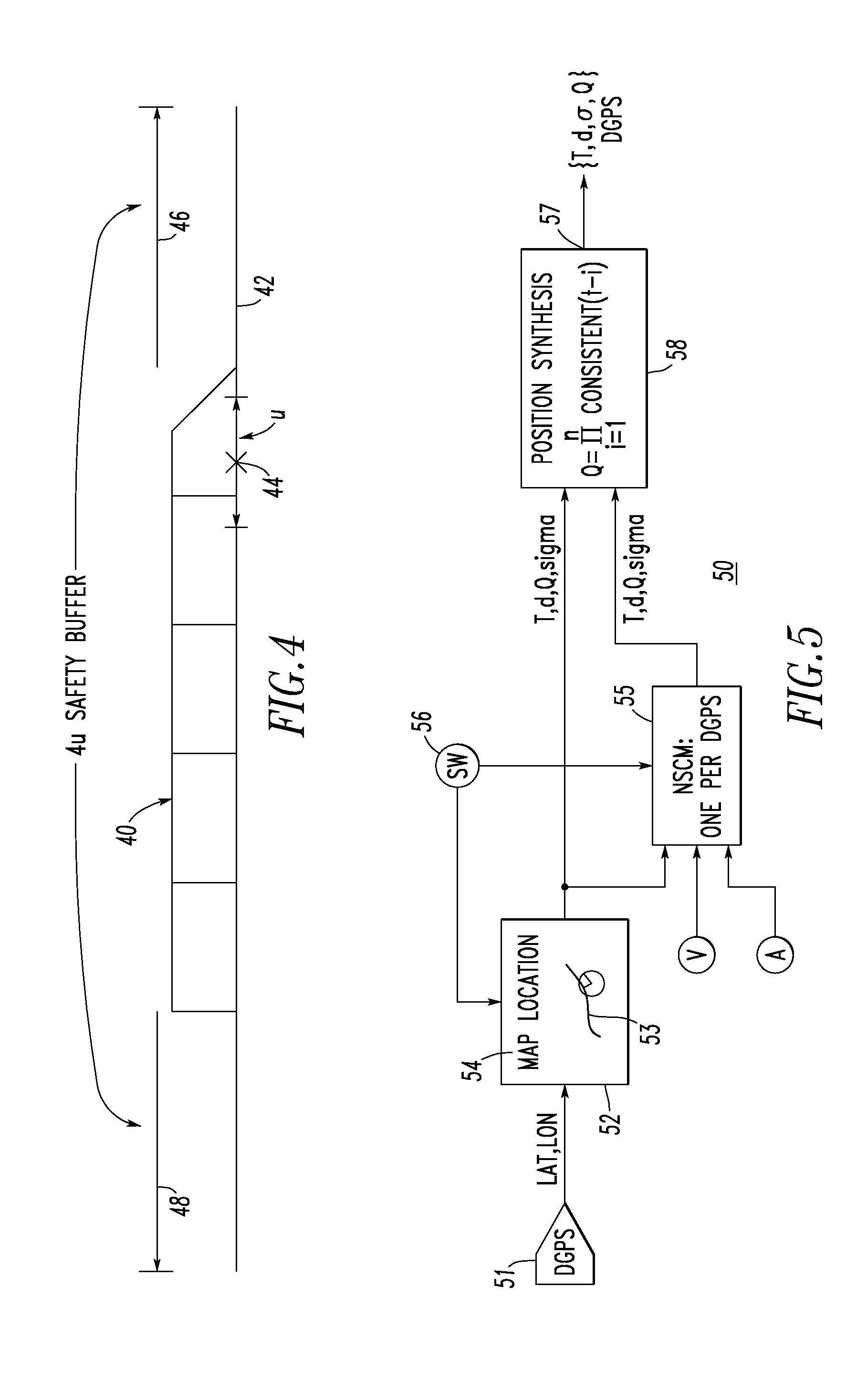System and method for vitally determining position and position uncertainty of a railroad vehicle employing diverse sensors including a global positioning system sensor
- Summary
- Abstract
- Description
- Claims
- Application Information
AI Technical Summary
Benefits of technology
Problems solved by technology
Method used
Image
Examples
example 1
[0078]DGPS σ (commonly known as the User Equivalent Range Error (UERE)) is determined in part from Differential Lock and Horizontal Dilution of Precision (HDOP) values reported by the DGPS unit 100 and is presumed to be on the order of about 1.6 meters (5 feet). HDOP depends on the relative geometric positioning of the satellites in view (higher values of HDOP indicate relative positions that give less accurate readings). For GPS without differential correction, GPS σ is presumed to be on the order of about 5.3 meters (18 feet), such that 6σ under GPS, without differential correction, is still only about 32 meters (108 feet), which is sufficiently small for railway applications. DGPS σ is smaller because the locations of ground-based reference stations, which are known, are used to correct for atmospheric distortion, ephemeris error, and satellite / receiver clock error. The actual UERE is tracked by the GPS Support Center of the Air Force, currently known as GPSOC. As new satellites ...
example 2
[0085]The DGPS error propagation routine 50 may employ, for example, GPS reported Differential Lock and HDOP to calculate UERE. The UERE calculation is based on the observation that GPS without differential lock has a normal standard deviation of about 5.3 meters. Adding a differential GPS base unit signal will reduce the ULERE value to about 1.6 meters. Additionally, the grouping of the GPS satellites (not shown) used in the measurement has an effect, which is measured by the HDOP. For example, tightly clustered satellites lead to a relatively large HDOP, while more widely scattered satellites lead to a relatively lower HDOP.
[0086]HDOP is defined such that UERE=HDOP*√{square root over (URE2+UEE2)}, wherein UEE is User Equipment Errors (e.g., receiver noise; antenna orientation; EMI / RFI), which can be reduced to an insignificant value with appropriate equipment design, and URE is the User Range Error, which is due to atmospheric effects (e.g., propagation through the ionosphere), or...
example 3
[0095]The DGPS error propagation routine 50 can employ a routine to verify DGPS veracity. In addition to selecting a suitable UERE value (e.g., Example 2, above), the system 90 preferably determines whether the DGPS unit 100 (FIG. 9) is accurately reporting differential lock and HDOP. The method is similar to Example 2, except that each sample offset is compared to the particular UERE implied by the differential lock and HDOP reported with that sample, instead of a presupposed UERE (the URE value is known, and is constant). Thus, the proportion computed is a measure of whether the DGPS unit 100 is accurately reporting differential lock and HDOP. If the value for z lies within the acceptable range of z values, which depends on the chosen level for statistical significance (e.g., 5%), then the hypothesis that the DGPS unit 100 can be believed is accepted.
PUM
 Login to View More
Login to View More Abstract
Description
Claims
Application Information
 Login to View More
Login to View More - R&D
- Intellectual Property
- Life Sciences
- Materials
- Tech Scout
- Unparalleled Data Quality
- Higher Quality Content
- 60% Fewer Hallucinations
Browse by: Latest US Patents, China's latest patents, Technical Efficacy Thesaurus, Application Domain, Technology Topic, Popular Technical Reports.
© 2025 PatSnap. All rights reserved.Legal|Privacy policy|Modern Slavery Act Transparency Statement|Sitemap|About US| Contact US: help@patsnap.com



